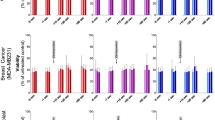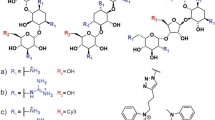Summary
Heat-induced (45.5°C) modification of adriamycin uptake and efflux were measured by flow cytometry in CHO cells in vitro. Administration of adriamycin with simultaneous 15-min or 30-min heat treatment increased drug uptake in a dose-dependent manner. Fluorescence-activated cell sorting showed that cytotoxicity to adriamycin was correlated with relative cellular concentration (fluorescence) for both unheated cells and those heated and simultaneously treated with adriamycin. However, if adriamycin administration followed the heat treatment, accumulation was significantly reduced, primarily as a result of decreased passive drug diffusion (rather than increased efflux) in the heated cells. Cells made heat-tolerant by prior heating also exhibited reduced adriamycin uptake 12 h later, and further heating did not increase uptake. Cell sorting experiments indicated that cytotoxicity of adriamycin was not necessarily correlated with intracellular drug levels when drug administration followed the heat treatment. Also, heat-sterilized cells exhibited a two-fold increase in adriamycin uptake over surviving cells, as assessed by simultaneous measurement of dansyl lysine and adriamycin content. These results indicate that sensitization to adriamycin by simultaneous heat treatment is probably due to increased drug uptake. The decreased sensitization observed when drug administration is followed by heating is probably the result of both decreased uptake and decreased drug DNA accessibility.
Similar content being viewed by others
References
Calderwood SK, Hahn GM (1983) Thermal sensitivity and resistance of insulin receptor binding. Biochim Biophys Acta 756: 1–8
Chambers SH, Bleehan WM, Watson JV (1984) Effect of cell density on intracellular adriamycin concentration and cytotoxicity in exponential and plateau phase EMT-6 cells. Br J Cancer 49: 301–306
DiMarco A (1975) Adriamycin (NSC-123127): mode and mechanism of action. Cancer Chemother Rep 6: 91–129
Hahn GM (1982) Hyperthermia to enhance drug delivery. In: Chabner S (ed) Rational basis for chemotherapy. Liss, New York, pp 427–436
Hahn GM, Shiu E (1977) Interactions of amphotericin B and 43°C hyperthermia. Cancer Res 37: 761–764
Hahn GM, Strande DP, (1976) Cytotoxic effects of hyperthermia and adriamycin on Chinese hamster cells. JNCI 57 (2): 1063–1067
Humphries GMK, Lovejoy JP (1983) Dansyl lysine: a structure selective fluorescent membrane stain? Biophys J 42: 307–310
Humphries GMK, Lovejoy JP (1984) Lateral phase separation of phospholipids as a basis of increased permeability of membranes and other chemical species. J Membrane Biol 80: 249–256
Inaba M, Kobayashi H, Sakurai Y, Johnson RK (1979) Active efflux of daunorubicin and adriamycin in sensitive and resistant sublines of P388 leukemia. Cancer Res 39: 2200–2203
Li GC, Hahn GM (1981) Ethanol-induced tolerance to heat and adriamycin. Nature 274: 699–701
Magun BE, Fennie CW (1978) Effects of hyperthermia on binding, internalization and degregation of epidermal growth factor. Radiat Res 86: 133–146
McGown AT, Ward TH, Fox BW (1984) Comparative studies of the uptake of daunorubicin in sensitive and resistant P388 cell lines by flow cytometry and biochemical extraction. Proc Cancer Chemother Pharmacol 11: 113–116
Mehdi SQ, Recktenwald DJ, Smith LM, Li GC, Armour EP, Hahn GM (1984) The effect of hyperthermia on murine cell surface histocompatibility antigens. Cancer Res 44: 3394–3397
Mikkelsen RB, Koch B (1981) Thermosensitivity of membrane potential of normal and simian virus 40-transformed hamster lymphocytes. Cancer Res 41:209–215
Peters DC, Dean PN, Pinkel D (1981) The Livermore flow cytometer. Lawrence Livermore National Laboratory Report UCID-199260, Livermore CA
Rice GC, Fisher G, Devlin M, Humphries GMK, Mehdi SQ, Hahn GM (1985) Use ofN-ζ-dansyl-L-lysine and flow cytometry to identify heat-killed mammalian cells. Int J Hyperthermia 1: 185–191
Rice GC, Fisher K, Fisher G, Hahn GM (1987) Membrane protein aggregation and formation of lateral phospholipid domains directly correlates with cell killing by heat, ethanol and polyene antibiotics in Chinese hamster fibroblasts (in press)
Rice GC, Gray JW, Dewey WC (1985) FACS analysis of a hyperthermia-induced alteration in Hoechst 33342 transport and direct measurement of its relationship to cell survival. J Cell Physiol 122:387–396
Roti Roti JL, Henle KJ, Winward RT (1980) The kinetics of increase in chromatin protein content in heated cells: a possible role in cell killing. Radiat Res 81:138–144
Skovsqaard T (1977) Transport and binding of daunorubicin, adriamycin and rubidazone in Ehrlich ascites tumor cells. Biochem Pharmacol 26:215–222
Stevenson MA, Minton K, Hahn GM (1981) Survival and Con-A induced capping in CHO fibroblasts after exposure tohyperthermia, ethanol or x-irradiation. Radiat Res 86: 467–478
Stevenson AP, Galey WR, Tobye RA, (1983) Hyperthermia induced increase in potassium transport in Chinese hamster ovary cells. J Cell Physiol 115:75–86
Tritton TR, Yee G (1982) The anti-cancer agent adriamycin can be actively cytotoxic without entering cells. Science 217: 248–251
Yatvin MB (1977) The influence of membrane lipid composition and procaine on hyperthermic death of cells. Int J Radiat Biol 32:513–521
Yi PN (1979) Cellular ion changes during and after hyperthermia. Biochem Biophys Res Commun 911:117–182
Author information
Authors and Affiliations
Rights and permissions
About this article
Cite this article
Rice, G.C., Hahn, G.M. Modulation of adriamycin transport by hyperthermia as measured by fluorescence-activated cell sorting. Cancer Chemother. Pharmacol. 20, 183–187 (1987). https://doi.org/10.1007/BF00570481
Accepted:
Issue Date:
DOI: https://doi.org/10.1007/BF00570481




